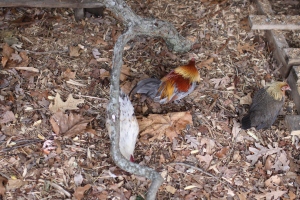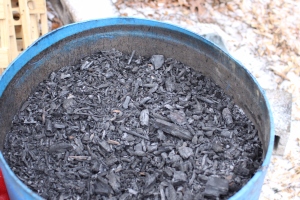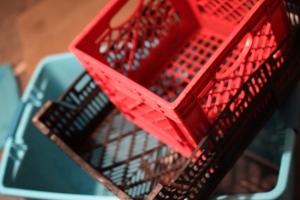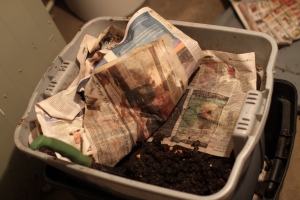
These chickens are “free-ranging” in my barn, and dropping nitrogen to be converted into your compost.

35 gallons of homemade biochar.

The perforated gray worm bin is placed insidethe black bin. The black bin contains 4 bricks on top of newspaper. The vermacompost tea is absorbed by the news paper, and placed back on top of the compost in the gray bin.

The vermacompost is removed from the covered bin and first scooped into the red basket (w/ larger holes) just above the black carrier (w/ smaller holes). I first shake the red one until I’m left with larger clumps and dump them back into the original gray container. I then sift the smaller granules out of the black carrier, leaving the worm castings (and some worms) in the large blue bin.

This is filled with red wigglers worms, and kitchen scraps.
I think that one of the best ways to market is to educate. I’m not going to tell you to buy something you don’t think you need or want; however, I can show you why you should. I stand by our product, BioCharged, because I make it. As depicted in the pictures, it’s produced in my humble basement, right next to my furnace. My biochar kiln sits in my back yard, and reportedly looks like a distillery of sorts.
Mixing the biochar and vermacompost creates the most ideal soil additive available. It’s organic, houses a plethora of microbial activity, keeps nutrients in your soil, holds moisture, removes impurities, and has appreciable carbon sequestration value.
In our raised beds, we mix peat moss, vermiculite, and compost. Click the link to find out how much and why. Once that combination is mixed evenly, we add our additive, biocharged. Use one 5-gallon bucket for a 4’X8′ raised bed.
Our soil blend is the most expensive part of our raised bed production. It is also the most crucial. Our goal is to ensure you not only begin gardening, but also succeed. Having the best soil possible is going to increase your food production and decrease your maintenance: less watering and weeding–more picking and eating. When you buy a raised bed from Avalon, your purchase can pay for itself in a few years with a little planning and attention.
If you ever have any questions, please contact us. We want your business, and more importantly, we want to see NW Ohio get healthier, smarter, and prettier.
Leave a comment